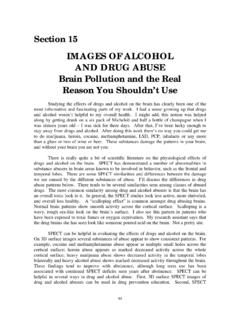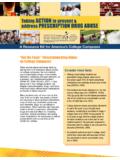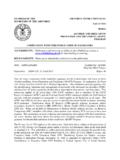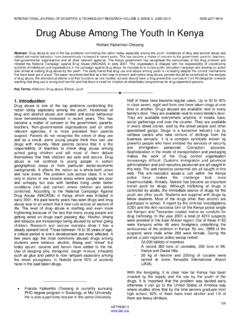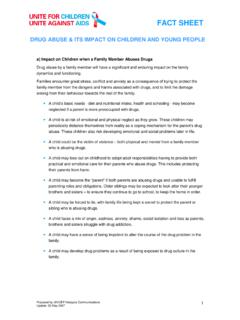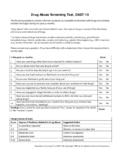Transcription of Parental Drug Use as Child Abuse
1 Children s Bureau/ACYF/ | Email: | StatuteSCurrent Through April 2015 Parental drug use as Child abuseWhat S InSIdePrenatal drug exposureChildren exposed to illegal drug activityFull-text excerpts of State lawsto find statute information for a particular State, go to of drugs or alcohol by parents and other caregivers can have negative effects on the health, safety, and well-being of children. Approximately 47 States, the District of Columbia, Guam, and the Virgin Islands have laws within their Child protection statutes that address the issue of substance Abuse by The word approximately is used to stress the fact that States frequently amend their laws.
2 This information is current through April 2015. The statutes in American Samoa, Connecticut, New Jersey, Northern Mariana Islands, Puerto Rico, and Vermont do not currently address the issue of children exposed to illegal drug activity. Two areas of concern are the harm caused by prenatal drug exposure and the harm caused to children of any age by exposure to illegal drug activity in their homes or environment. material may be freely reproduced and distributed. However, when doing so, please credit Child Welfare Information Gateway.
3 This publication is available online at drug exposureThe Child Abuse Prevention and Treatment Act (CAPTA) requires States to have policies and procedures in place to notify Child protective services (CPS) agencies of substance-exposed newborns (SENs) and to establish a plan of safe care for newborns identified as being affected by illegal substance Abuse or having withdrawal symptoms resulting from prenatal drug 42 5106a(b), as amended by the CAPTA Reauthorization Act of 2010 ( 111-320). For more information on these issues, as well as training resources and technical assistance, visit the website of the National Center on Substance Abuse and Child Welfare at Several States currently address this requirement in their statutes.
4 Approximately 19 States and the District of Columbia have specific reporting procedures for infants who show evidence at birth of having been exposed to drugs, alcohol, or other controlled substances; 14 States and the District of Columbia include this type of exposure in their definitions of Child Abuse or Alaska, Arizona, Arkansas, California, Illinois, Iowa, Kentucky, Louisiana, Maine, Massachusetts, Michigan, Minnesota, Missouri, Montana, Nevada, Oklahoma, Pennsylvania, Utah, and Virginia have enacted specific reporting procedures for drug -exposed infants.
5 Arizona, Arkansas, Colorado, Florida, Illinois, Indiana, Louisiana, Minnesota, North Dakota, South Carolina, South Dakota, Texas, Virginia, and Wisconsin include exposure of infants to drugs in their definitions of Child Abuse or States specify in their statutes the response the CPS agency must make to reports of SENs. Maine requires the State agency to develop a plan of safe care for the infant. California, Maryland, Minnesota, Missouri, Nevada, Pennsylvania, and the District of Columbia require the agency to complete an assessment of needs for the infant and for the infant s family and to make a referral to appropriate services.
6 Illinois and Minnesota require mandated reporters to report when they suspect that pregnant women are substance abusers so that the women can be referred for exposed to Illegal drug activityThere is increasing concern about the negative effects on children when parents or other members of their households Abuse alcohol or drugs or engage in other illegal drug -related activity, such as the manufacture of methamphetamines in home-based laboratories. Many States have responded to this problem by expanding the civil definition of Child Abuse or neglect to include this concern.
7 Specific circumstances that are considered Child Abuse or neglect in some States include: Manufacturing a controlled substance in the presence of a Child or on premises occupied by a child44 In 11 States (Alabama, Colorado, Indiana, Iowa, Montana, Oklahoma, Oregon, Pennsylvania, South Dakota, Tennessee, and Wisconsin) and the District of Columbia. Exposing a Child to, or allowing a Child to be present where, chemicals or equipment for the manufacture of controlled substances are used or stored55 In 8 States: Alabama, Arizona, Arkansas, Iowa, New Mexico, North Dakota, Oklahoma, and Oregon.
8 Selling, distributing, or giving drugs or alcohol to a Child 66 In 7 States (Arkansas, Florida, Hawaii, Illinois, Iowa, Minnesota, and Texas) and Guam. Using a controlled substance that impairs the caregiver s ability to adequately care for the child77 In 11 States: California, Delaware, Florida, Iowa, Kentucky, Minnesota, New York, Oklahoma, Rhode Island, Texas, and West Virginia. Exposing a Child to the criminal sale or distribution of drugs88 Montana, South Dakota, and the District of 34 States and the Virgin Islands address in their criminal statutes the issue of exposing children to illegal drug Alabama, Alaska, Arizona, Arkansas, California, Colorado, Delaware, Georgia, Hawaii, Idaho, Illinois, Indiana, Iowa, Kansas, Kentucky, Louisiana, Minnesota, Mississippi, Missouri, Montana, Nebraska, New Hampshire, New Mexico, North Carolina, North Dakota, Ohio, Oregon, Pennsylvania.
9 South Carolina, Utah, Virginia, Washington, West Virginia, and Wyoming currently address the issue in their criminal statutes. For example, in 20 States the manufacture or possession of methamphetamine in the presence of a Child is a felony,1010 Arkansas, California, Colorado, Georgia, Illinois, Iowa, Kansas, Kentucky, Louisiana, Missouri, Montana, Nebraska, New Hampshire, Ohio, Pennsylvania, South Carolina, Virginia, Washington, West Virginia, and Wyoming. while in 10 States, the manufacture or possession of any controlled substance in the presence of a Child is considered a Alabama, Colorado, Hawaii, Idaho, Indiana, Kentucky, Louisiana, New Mexico, Ohio, and Oregon.
10 Nine States have enacted enhanced penalties for any conviction for the manufacture of methamphetamine when a Child was on the premises where the crime Arkansas, California, Hawaii, Mississippi, Montana, North Carolina, Ohio, Virginia, and drug Use as Child material may be freely reproduced and distributed. However, when doing so, please credit Child Welfare Information Gateway. This publication is available online at children to the manufacture, possession, or distribution of illegal drugs is considered Child endangerment in 11 Alaska, Arizona, Delaware, Illinois, Iowa, Kansas, Kentucky, Minnesota, Missouri, Montana, and Washington.










